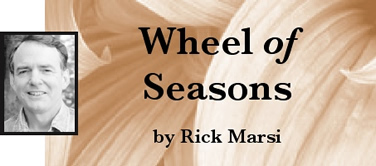What’s a heat wave? Wildlife survives in style
There’s been no lack of discussion around here as to what constitutes a heat wave. Some people think we had one in July. Others don’t.
Those who do: any and all humans who recently found their stems wilting under a radiant assault that featured sticky sheets and drooping psychological profiles.
The ones who don’t: local meteorologists, normal folks for the most part but prone to playing things by the book. Sure it’s been hot, they say, but not hot enough for a heat wave.
“One must read 90 degrees or more on one’s shaded thermometer for a number of consecutive days before declaring the presence of a heat wave,” is an approximation of their official decree.
Before a “cold” front blew into town recently, the daily high temperature in this section of the Northeast had averaged above 85 for nearly two weeks. In a flurry of adaptation, resident humans retaliated by hiding in air-conditioned bedrooms and movie theaters. Ice cubes became a medium of exchange. People were getting up at 4 a.m. to mow the lawn.
It was broiling by 10 a.m.
“That’s a near heat wave,” the meteorologists said from their hilltop weather station, where zephyrs bend wildflower stems and the steaming streets of distant Metropolitan City appear as a shimmering mirage. “Close, but not quite.”
Disappointed to learn there wasn’t adequate cause for complaint, we looked to the woods and fields for solace. Perhaps birds and bees were holding up under the heat in more exemplary fashion than we humans with whom they share the outdoors.
It tuned out they were. Whether by adapting to summer’s solar persistence, or by ignoring it completely, the surrounding flora and fauna had figured out how to survive in style.
Some examples from our July notebook:
• Wood thrushes are sleeping these hot days away. We awake at 5 a.m. and hear their songs wafting from a forest still holding night coolness. They will sing for two hours and then stop until almost nightfall. When purple washes the horizon, their soft melodies will resume and we will listen, sitting on the porch feeling almost cool.
• Roadside and other waste-place flowers, on the other hand, bake happily in midday heat. “Full sun!” they scream when skies grow momentarily gray. Clumps of hot pink fireweed; giant, fuzzy mulleins; sprawling sky-blue chicory: they like their elements hard-edged. A few rocks, a little dirt, some blazing sun – that’s the good life.
• A doe and her speckled fawn wait for twilight before meandering into an open field. Growing fat through the summer, they stop to watch and sniff us. We watch back, wishing we could sniff on equal terms. The doe’s coat is a soft summer painting, a blend of reds and browns as soft as mist on rose petals.
• Farther north, we watch loons and their fuzzy chicks diving in lakes that are cooler than blacktop cities. We see ospreys circle massive stick nests and hear peeps from their young housed within. A bullfrog – bulbous lily pad sphinx – poses for pictures.
• Broad-winged hawks spiral upward on noonday thermals. Beavers tow clumps of scrub willow through tepid river shallows. Sparrows spray from roadside grasses, their weed seed hunting disturbed.
Heat wave? I guess so, but the natural world – without benefit of a single ice cube – seems slightly less than concerned.
Naturalist Rick Marsi, a member of the Susquehanna Group, is a journalist, public speaker and leader of eco-tours. His book of favorite nature columns is Wheel of Seasons, available at www.rickmarsi.com. ©2013 Rick Marsi
